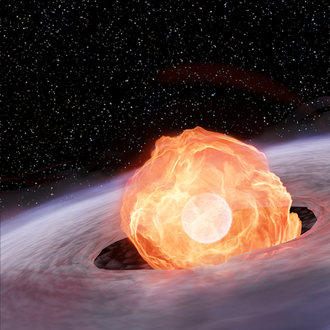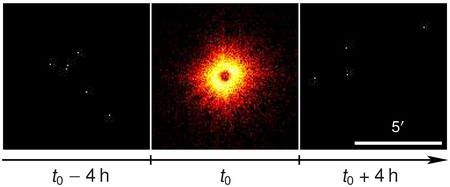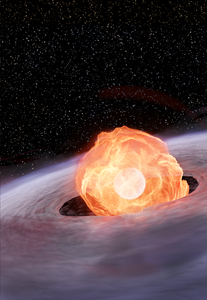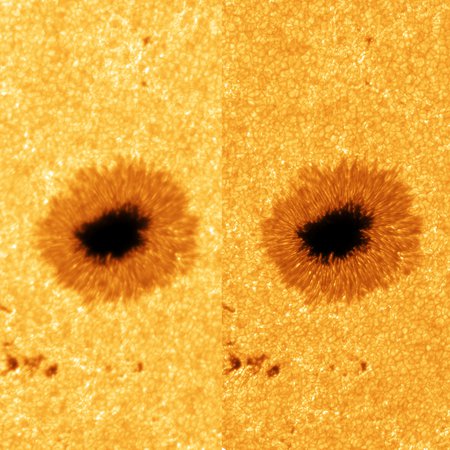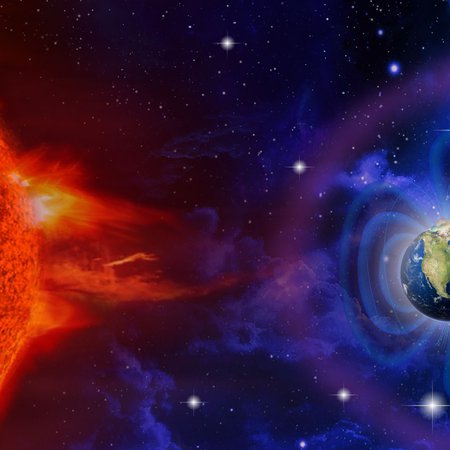X-ray fireball of a nova
The X-ray telescope eROSITA discovered for the first time the early phase of a thermonuclear explosion and thus confirms a decades-old prediction of a nova model.
A nova – a phenomenon observed by humankind for thousands of years. An apparently new star appears in the sky, remains visible for a few weeks, and gradually disappears. Only about 60 years ago a fundamental understanding of this phenomenon was developed: a nova is a nuclear explosion on the surface of a white dwarf star. The then very brightly shining shell, which then cools rapidly and expands with a speed of several 1000 kilometres per second, is responsible for the optical appearance of an apparently new star. According to a prediction from the 1990s, the initial ignition should be noticeable by a flash of X-ray light. However, it has never been detected because of the brevity and rarity of the event. An international research team which includes the Leibniz Institute for Astrophysics Potsdam (AIP) now reports the first detection of a nova in the early fireball phase with the X-ray telescope eROSITA. "A bit of luck is part of life, sometimes you just have to be in the right place at the right time," says AIP scientist PD Dr Axel Schwope, who contributed to the scientific evaluation. The discovery contributes an essential element to the understanding of the nova phenomenon.
“It was to some extent a fortunate coincidence, really,” explains Ole König, PhD student at the Astronomical Institute of the Friedrich Argelander University of Erlangen-Nuremberg (FAU), lead author of the study. The astrophysicist describes the difficulties: “These X-ray flashes last only a few hours and are almost impossible to predict – the observational instrument must be pointed directly at the explosion at exactly the right time”. The detection was achieved with the eROSITA X-ray telescope, which has been scanning the sky for soft, meaning low-energy, X-rays one and a half million kilometers from Earth since 2019. In the process, extremely strong X-rays were measured on 7 July 2020, in an area of the sky that had been completely unremarkable four hours earlier. When the X-ray telescope resampled the same area of the sky four hours later, the source of the radiation had disappeared again. The X-ray flash thus had lasted less than eight hours. It was not until 11 hours later that optical telescopes detected the nova, which eventually became bright enough to be visible to the naked eye – the second brightest nova in the past decade. The temporal and spatial coincidence of the optical nova apparition and the X-ray flash eventually led to the explanation of the flash as an early fireball of the nova.
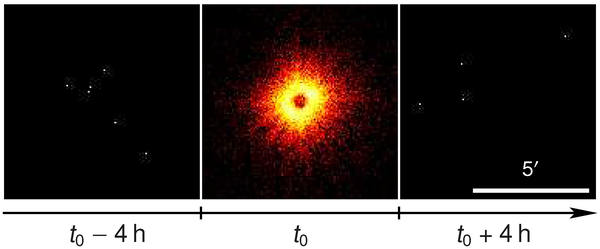
Sky images of all seven eROSITA cameras combined. At t0 (7 July 2020), during the second all-sky survey, eROSITA detected a bright, new, soft X-ray flash. No source can be seen in the scans four hours before and after the event.
Credit: König et al., 2022When stars like our Sun have used up their fuel, what remains is a hot so-called white dwarf star. White dwarfs have about the mass of our Sun but only the size of our Earth. The matter inside is highly compressed. These ratios can be easily imagined using an example: “One way to picture these proportions is to think of the Sun being the same size as an apple, which means Earth and also the white dwarf would be the same size as a pin head. A teaspoon of matter from the inside of a white dwarf easily has the same mass as a large truck,“ explains Professor Jörn Wilms (FAU), second author of the study. These objects are still hot and therefore glow whitish. However, this radiation is weak because of the smallness of the white dwarfs and therefore difficult to detect from Earth.
Unless the white dwarf is accompanied by a star in which the solar fire is still burning, that is, and from which fresh stellar material, especially hydrogen, can then transfer to it. "This hydrogen can collect over time to form a layer only a few metres thick on the surface of the star's surface," Jörn Wilms explains. In this layer, however, the huge force of gravity creates a gigantic pressure that can become so great that the stellar fire reignites. In a chain reaction, it soon comes to a huge explosion during which the layer of hydrogen is blown off. The X-ray radiation of an explosion like this is what hit the detectors of eROSITA on July 7, 2020 producing an overexposed image. Detailed analysis of the X-ray observations then revealed that at the time of observation, the fireball had a radius about three to five times that of Earth at a temperature of about 330,000 degrees, and that the white dwarf should have about 90 percent of the mass of our Sun and thus be relatively massive.
The research team reports its findings in the journal Nature and includes members from FAU, the Max Planck Institute for Extraterrestrial Physics in Garching, the Eberhard Karls University of Tübingen, the Universitat Politécnica de Catalunya in Barcelona and the Leibniz Institute for Astrophysics Potsdam (AIP).
Further information
Original Publication
König, O., Wilms, J., Arcodia, R. et al. X-ray detection of a nova in the fireball phase.Nature 605, 248–250 (2022)
https://www.nature.com/articles/s41586-022-04635-y
DOI: https://doi.org/10.1038/s41586-022-04635-y
FAU press release (in German)
https://www.fau.de/2022/05/news/wissenschaft/explosion-auf-einem-weissen-zwerg-direkt-beobachtet
Images
Sky images of all seven eROSITA cameras combined. At t0 (7 July 2020), during the second all-sky survey, eROSITA detected a bright, new, soft X-ray flash. No source can be seen in the scans four hours before and after the event.
Big screen size [1000 x 416, 120 KB]
Original size [2384 x 992, 120 KB]
Artist’s impression of an X-ray fireball on a white dwarf star.
